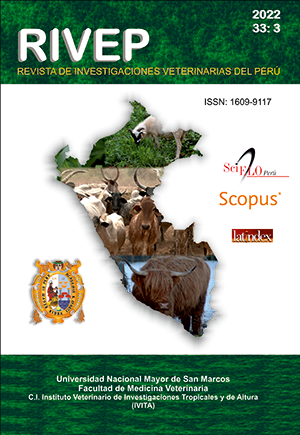Serotyping and genetic detection of Salmonella spp of avian origin
DOI:
https://doi.org/10.15381/rivep.v33i3.22893Keywords:
Salmonella, serovar, invA gene, PCR, serotypingAbstract
The aim of this study was to molecularly and serologically identify Salmonella spp present in isolates from avian eggs, carcasses, and viscera. In total, 46 isolates of avian origin identified as Salmonella spp were evaluated through cultures and biochemical tests in the period 2012-2017 from various districts of Lima. These isolates are kept in the Bacteriology Laboratory stock of the Universidad Nacional Mayor de San Marcos. The strains were reactivated, and suspicious Salmonella spp colonies were reconfirmed by culturing on selective media. Subsequently, the PCR was performed on the suspicious samples as a method of genetic diagnosis of Salmonella. The invasiveness gene invA, a gene involved with the virulence of Salmonella, was detected. Serotyping was performed with polyvalent and monovalent antisera for serogroup and serovar in the Enteropathogens Laboratory of the National Institute of Health (INS), and finally the serovars were determined according to the scheme proposed by Kauffmann-White. The 46 strains showed molecular weight bands corresponding to the invA gene (244 bp). All strains were identified by serotyping, obtaining S. Infantis (34.8%), S. Pullorum (34.8%), S. Gallinarum (15.2%), S. Enteritidis (8.7%) and S. Typhimurium (6.5%). The results reveal the predominance of circulating serovars in avian samples, as well as their implication in public health.
Downloads
Downloads
Published
Issue
Section
License
Copyright (c) 2022 Freshia Huarcaya R., Sonia Calle E., Juan Siuce M., André Sedano S., Jhonatan Huamaní P., Arturo García B., Luis Álvarez V., Sofía Gonzales M.

This work is licensed under a Creative Commons Attribution 4.0 International License.
AUTHORS RETAIN THEIR RIGHTS:
a. Authors retain their trade mark rights and patent, and also on any process or procedure described in the article.
b. Authors retain their right to share, copy, distribute, perform and publicly communicate their article (eg, to place their article in an institutional repository or publish it in a book), with an acknowledgment of its initial publication in the Revista de Investigaciones Veterinarias del Perú (RIVEP).
c. Authors retain theirs right to make a subsequent publication of their work, to use the article or any part thereof (eg a compilation of his papers, lecture notes, thesis, or a book), always indicating the source of publication (the originator of the work, journal, volume, number and date).










